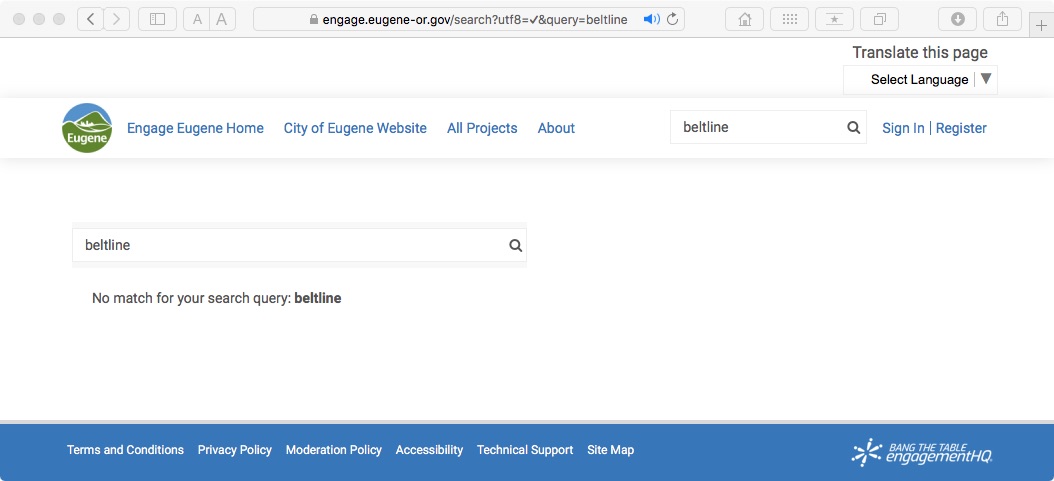supersizing Beltline highway, Eugene, Oregon
related: Beltline / I-5 interchange (completed) - Beltline / West Eugene Porkway interchange (No Build)
- summary
- Eugene Weakly coverage
- 2018 design: up to 16 lanes wide
- 2014: 10 to 11 lanes
- ODOT "low build"
- Delta - BL interchange
- TREES: Traffic, Energy, Ecology, Sustainability
- City & climate org censorship
www.oregon.gov/odot/projects/pages/project-details.aspx?project=16223
ODOT planning new Beltline bridges 10 lanes wide at the Willamette River, roadway structures would be up to 16 lanes wide at the Delta highway interchange. This is the largest and most expensive transportation infrastructure expansion planned in Eugene for the rest of the oil era. The third of a billion dollars cost estimate is greater than the federal funds appropriated through the Biden infrastructure law for Oregon's broken bridges. (Our state's busted bridges would cost many billions to repair or replace.)
Beltline highway is the busiest road in Lane County, Oregon, with more daily traffic on Beltline across the Willamette River than on I-5 through Eugene-Springfield. The Oregon Department of Transportation has long planned widening of this road segment, but has never had money for construction. In recent years, ODOT withdrew the planned West Eugene Porkway (2007), widened I-5 across the river, and supersized the I-5 Beltline interchange.
In late 2019, ODOT started rebuilding the Beltline / Delta interchange and is finalizing an Environmental Assessment to widen Beltline across the river. A decade ago ODOT estimated the cost at a quarter billion dollars. Now, it's a third of a billion or more. ODOT and the City also plan a new four lane highway parallel to Beltline, allegedly for local traffic although the two local roads it would connect are each two lanes wide (one in each direction). The "local" bridge may serve as a temporary Beltline mainline bridge while the existing bridge is demolished and rebuild to wider specifications. The temporary and new bridges would total 10 lanes, and the ramps feeding to the east and west would make the roads even wider. 12 lanes on the west side of the bridges and 16 lanes on the east side.
To date, government planners and non-government organizations who claim to lead on climate concerns have ignored Beltline widening plans. I have been unable to find any politician, environmental / climate group, newspaper, community organization of any kind who have made a formal statement of concern or opposition to supersizing Beltline as climate change gets worse and fossil fuel limits kick in.
Eugene's "Envision" (Expand) Eugene program says they want to add another hundred thousand people to Eugene - many in River Road / Santa Clara / north Eugene. Springfield relocated key parts of its downtown to the Gateway area, now accomodated by a Californicated bigger Beltline I-5 interchange. This is is a primary motive for supersizing Beltline Highway and abolishing single home zoning. It will be hard to have urban gardens, suburban permaculture, neighborhood resilience if everything gets paved over (whether inside the UGB or outside). Meanwhile, conventional oil and gas are in decline with fracking sustaining the illusion of normality, for now. We're in the Wiley Coyote moment, we've sailed over the edge of the cliff and now are looking down.
this graphic is twice as big as can be displayed on the page, it's easier to read if you download it and view it in an image program
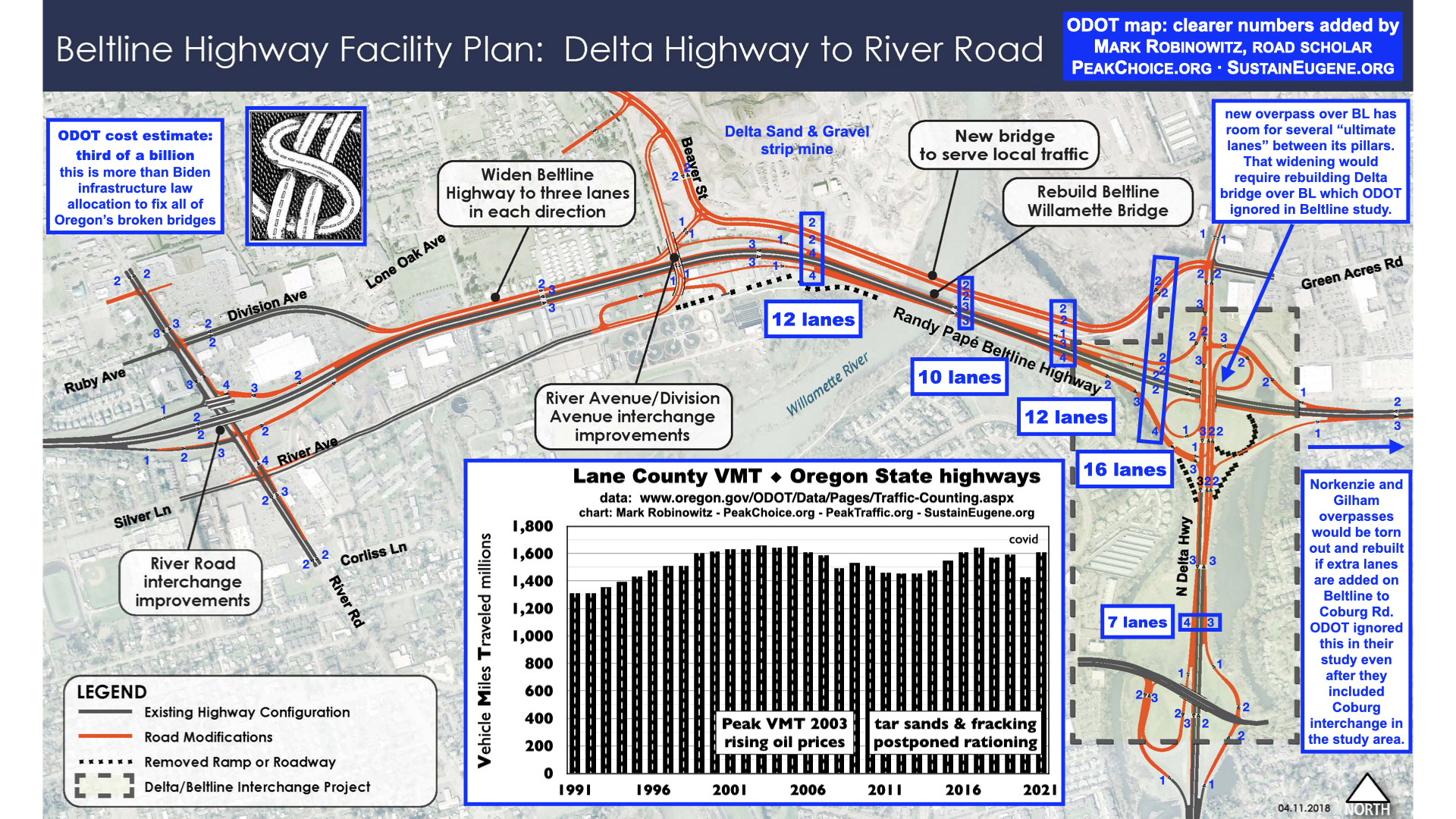
"In general, we recognize that STIP [State Transportation Improvement Program] modernization program funding levels will not meet the larger Metro and Non-metro project needs shown on the Countywide Priority List endorsed by the Board [of Commissioners] in October 2001 and updated April 1, 2002. For this reason, we have confined our comments to the ‘Smaller’ roadway projects shown on updated October List.
"Least cost solutions to transportation system needs is a prioritizing factor the OTC [Oregon Transportation Commission] will consider when selecting projects for the 04-07 STIP."
– Robert J. Pirrie, ODOT Area 5 Manager, May 1, 2002 letter to Lane County CommissionersThe Beltline expansion is the greatest cost approach to transportation.
only mention of Beltline expansion in Eugene Weakly: my letters
As far as I know, the only times Eugene Weakly has mentioned widening plans for Beltline has been my letters to the editor (see below). Perhaps if only Republican politicians supported highway expansions the Weakly, which supports Democrats, might bother to inform its readers.
The City of Eugene has branded itself as a municipal leader on climate and other ecological concerns, yet there has been no public pushback about the contrast between Beltline expansion and sustainability plans.
A decade ago, there was public controversy over plans to spend a quarter million dollars to rename Beltline highway after Randy Pape, a highway contractor who was also an Oregon Transportation Commissioner (in charge of determining ODOT policies). There has not been similar scrutiny about ODOT plans to spend over a quarter billion dollars to expand Beltline highway -- not even from Eugene's fabled environmental groups.
eugeneweekly.com/20150115/letters-editor/letters-editor-1-15-2015
FUTURE OF HIGHWAYS
EW’s year-end issue Dec. 31 discussed some dreams for the region’s rivers; here are two extra topics that are usually ignored.
ODOT is plotting an 11-lane-wide Beltline bridge over the Willamette River. The city of Eugene and Lane County are collaborating with this scheme, which is estimated to cost over a quarter billion dollars.
According to ODOT, traffic peaked in Lane County in 2003, yet the Beltline study claims it will increase nearly a third over the next 20 years. Will we have traffic jams after the low-flow shutdown of the Alaska pipeline and the decline of the fracking bubble?
The millions allocated for this bogus Environmental Impact Statement would be better spent directly on the Beltline “low-build” safety alternative to fix the Delta/Beltline interchange.
One response to energy depletion and climate change would be better intercity rail. Funds to widen Beltline would be better spent replacing the worn-out railroad bridge across the Willamette between Junction City and Harrisburg. Details at peaktraffic.org/beltline.html.
Perhaps the biggest damage to Oregon’s rivers is from corporate clearcuts and helicopter herbicides. While National Forest logging gets some scrutiny, the bigger problem of corporate cutting and spraying is rarely mentioned. This damage is permitted by our Democratic governor via the Oregon Department of Forestry.
Deforestation doesn’t only harm water quality, it also disrupts the hydrologic cycle, one of the factors behind climate change. Forestclimate.org has video from the “Clearcutting the Climate” conference that was held in Eugene in 2008.
Mark Robinowitz, Eugene
www.eugeneweekly.com/2010/05/06/letters.html
May 6, 2010
BIPARTISAN BOONDOGGLE
The controversy over spending a quarter million dollars to rename Beltline highway after Randy Papé overlooks the state’s plan to spend a thousand times more to widen our Beltline.
ODOT is spending millions to study expanding Beltline to 11 lanes wide, which would be the biggest road between Seattle and Sacramento. In November 2008, the Governor's "Transportation Vision Committee" said this would cost $250 million, part of an $18 billion plan for new and wider state highways.
In June 2001, Randy Papé, Jim Torrey and Bobby Green were part of the "West Eugene Charette," an intergovernmental summit that concluded the West Eugene Parkway was illegal and overpriced. Papé and other promoters then changed their minds and pushed through an advisory vote which split 51-49, claiming "the money is there" even though it was not. He then had ODOT spend $3 million to "study" the WEP despite knowing it couldn't be built — money that could have fixed the West 11th intersections.
Global oil production peaked in 2008, so planning bigger highways for the downslope of energy production is a waste worse than signs to honor a campaign contributor to the governor. If governments were really concerned about "sustainability," they would cancel plans to widen highways. ODOT doesn't even have the funds to study upgrading the railroad between Eugene and Portland to have high(er) speed rail, which would be more useful during the twilight of the oil era.
Mark Robinowitz, Eugene
[note: since this letter, ODOT found funds to study better train service between Eugene and Portland, but no funds were found to build anything. ODOT hopes to have six Cascades trains per day through the Willamette Valley by 2035, which would bring service back to the level of 1940 train service.]
www.oregon.gov/ODOT/COMM/docs/OTCpolicy_naming.pdf
Oregon Transportation Commission
POLICY
NUMBER
TRANSPORTATION COMMISSION-05
SUPERSEDES
TRANSPORTATION COMMISSION-01
EFFECTIVE DATE
OCT. 15, 1991
PAGE NUMBER 1 OF 1
REFERENCE
OREGON TRANSPORTATION COMMISSION MINUTES – OCTOBER 15, 1991
SUBJECT
NAMING HIGHWAY FACILITIES
The following guidelines are to be applied on a case-by-case basis:
I. The Oregon Transportation Commission generally will not name highway facilities after individuals.
II. The Oregon Transportation Commission may elect to suspend Guideline 1 if a requester can show compliance with the following criteria:
1. Demonstrated statewide support for naming a facility.
2. The honored individual shall have made a lasting contribution, with a significant and historic impact on Oregon.
3. The honored individual shall have been deceased for at least one year.
4. The facility is long enough to merit a title, such as a bridge or tunnel more than one-half mile long, or a highway section with defined end-points which was completed as a whole.III. The comments of the Oregon Geographic Names Board will be solicited prior to naming any highway facility. (Any federal recognition will be contingent upon their approval.)
2018 design: up to 16 lanes wide
These graphics are from the most recent ODOT presentation: Beltline Community Advisory Committee (CAC), November 28, 2018. ODOT has modified the earlier options from 2014 and developed even wider proposals.
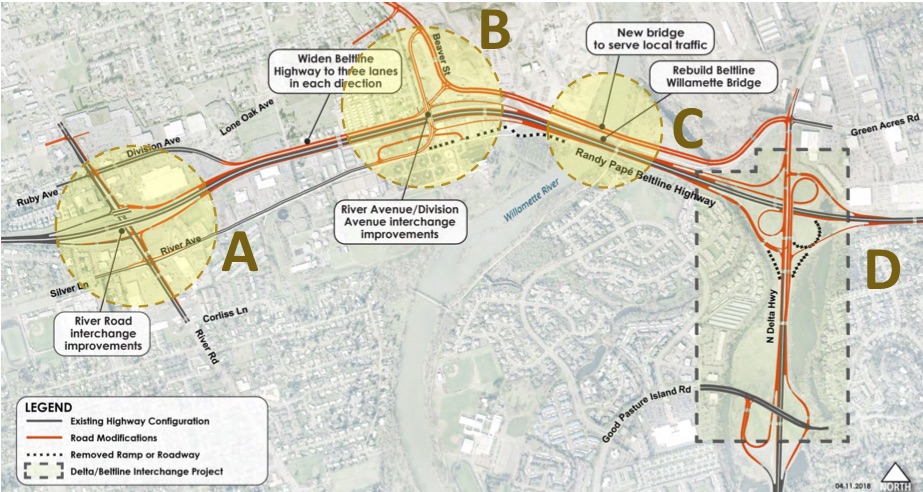
ODOT's 2018 report shows two alternatives for the west side of the bridge: big and bigger.
It's is Orwellian for ODOT to call an alternative "Improve Existing" when it would be the wider alternative, not a simple "improvement" of something already "existing."
The "Overcrossing / diamond" option on the right would be a little less cumbersome and expensive and it will likely be the "preferred alternative" of ODOT and Federal Highway Administration.
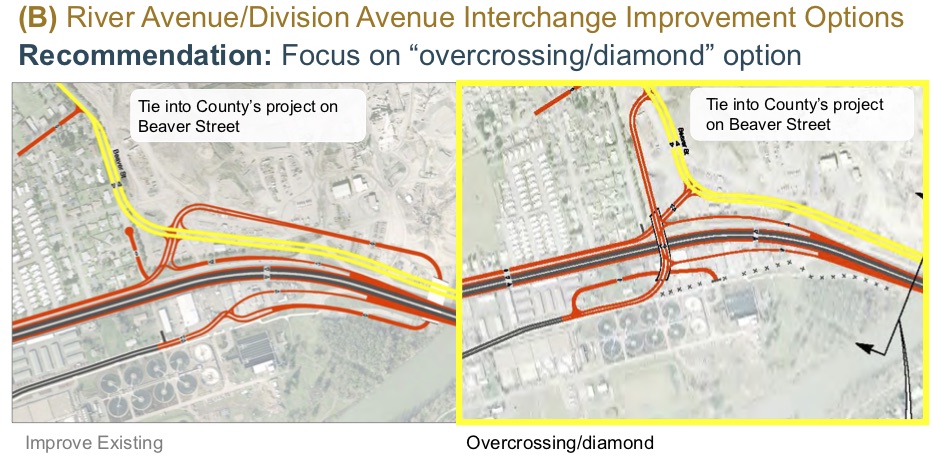
The Beltline expansion plan includes two bridges, a new six lane mainline bridge and a new four lane "local" bridge between Santa Clara and Delta highway.
The existing four lane Beltline bridge was built in the 1960s, two decades before the Cascadia Subduction Zone was discovered. It was not built with seismic safety standards.
It seems obvious that this "local" bridge would be built as a "temporary" Beltline bridge while the existing structure is torn out to make way for a bigger highway bridge. This temporary bridge could then have a second life as a local throughway between the exurbs of Santa Clara and Delta highway. However, this new road (the bridge connector) would connect to two lane roads on either side. Is the City hoping to widen those arteries - Beaver Street and Green Acres - to facilitate the extra hundred thousand people their "Envision Eugene" program says is the solution to climate change?
It is against Federal transportation law to build a new / wider highway that forces extra widening not considered in the Environmental Assessment or Environmental Impact Statement. The National Environmental Policy Act (NEPA) is a procedural law, not substantive. Federal actions that degrade the Earth can be approved as long as the full impacts are disclosed.
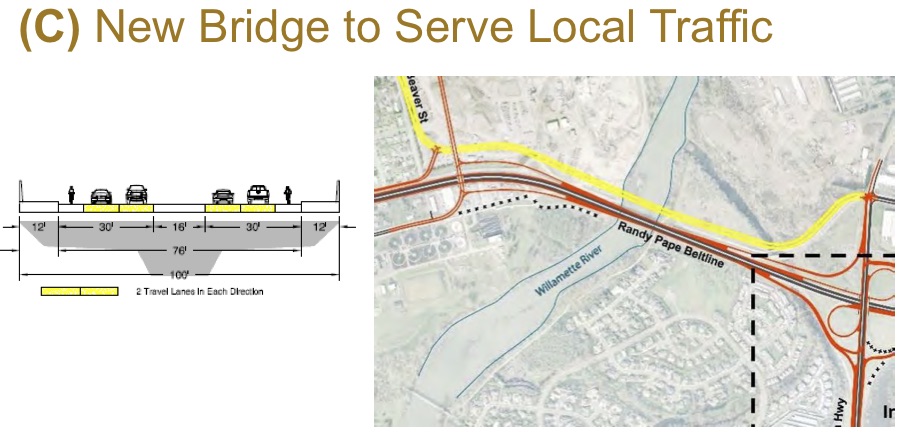
This graphic from ODOT misrepresents the actual decision that would be made to approve the Beltline widening. Title 23, United States Code, gives authority for transportation projects using federal funds to the US Department of Transportation, not local or state governments. For highways, the "Build" (or "No Build") decision is made by Federal Highway Administration. Local governments almost always make local plan decisions to include the project, but the actual approval is made by the feds. Ideally, all levels of government act together, but FHWA has legal power to override local government objections. FHWA even has power to seize local government managed land over local objections, but there are not many examples of this abuse. Most uses of eminent domain for road construction take land owned by individuals or businesses.
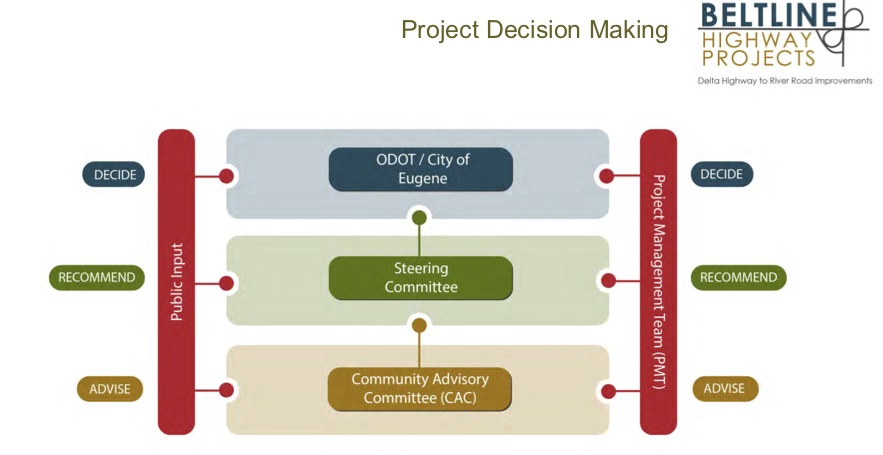
2014 designs: 10 to 11 lanes planned
These graphics were published by ODOT in 2014.
The 2018 designs are wider than these previous plans.
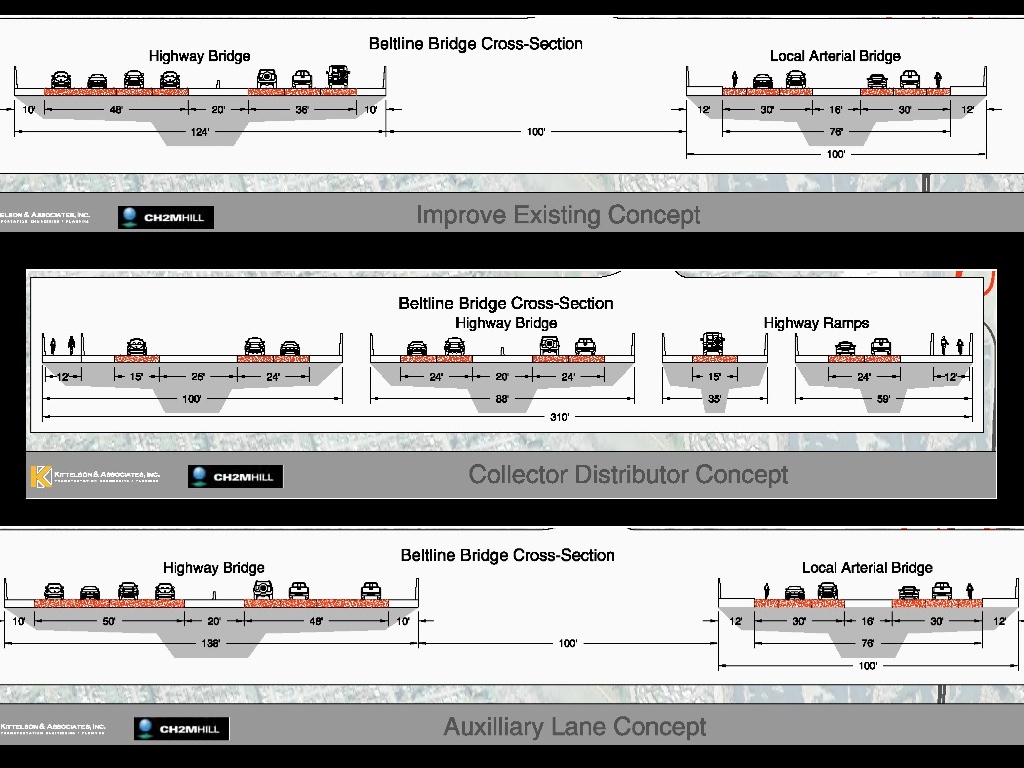
10 and 11 lane options at Beltline crossing of Willamette River

www.oregon.gov/ODOT/HWY/REGION2/pages/oregon569_beltlinehwy_public.aspx
Ramp Braid Concept
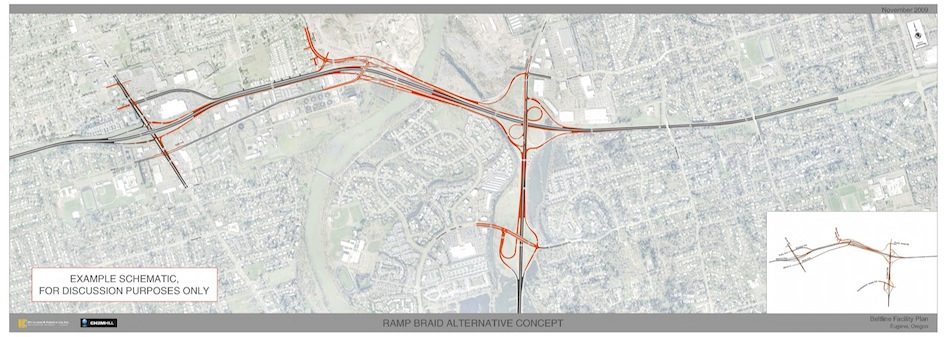
Beltline Highway widened to 11 lanes at river crossing
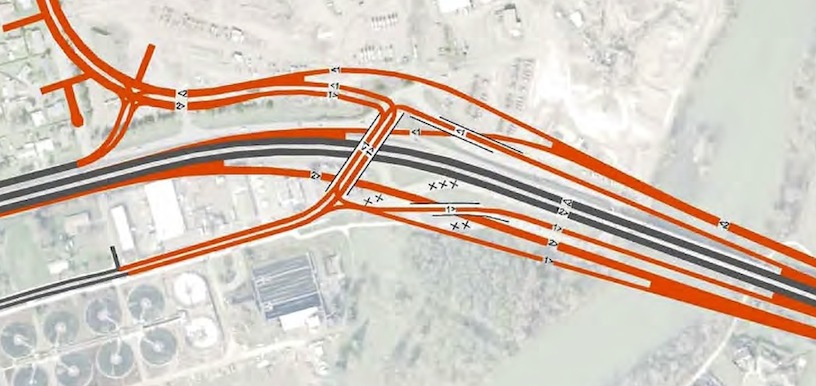
Delta Highway widened to 8 lanes south of Beltline interchange
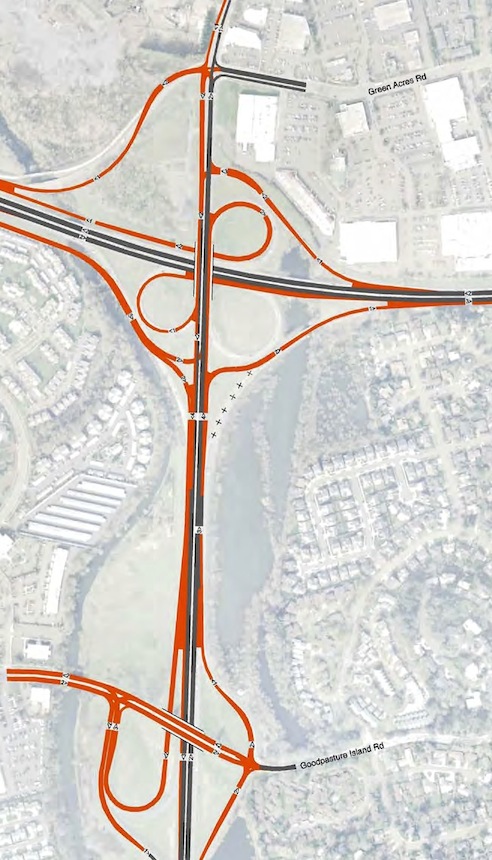
Low Build Alternative - 2009 maps
safety fixes for the energy downslope, no longer under consideration
note: Low Build Concept 3 would be almost the same design as the rebuild of the Delta Beltline interchange (with less expansion of Delta via the two lane bridge over Beltline)
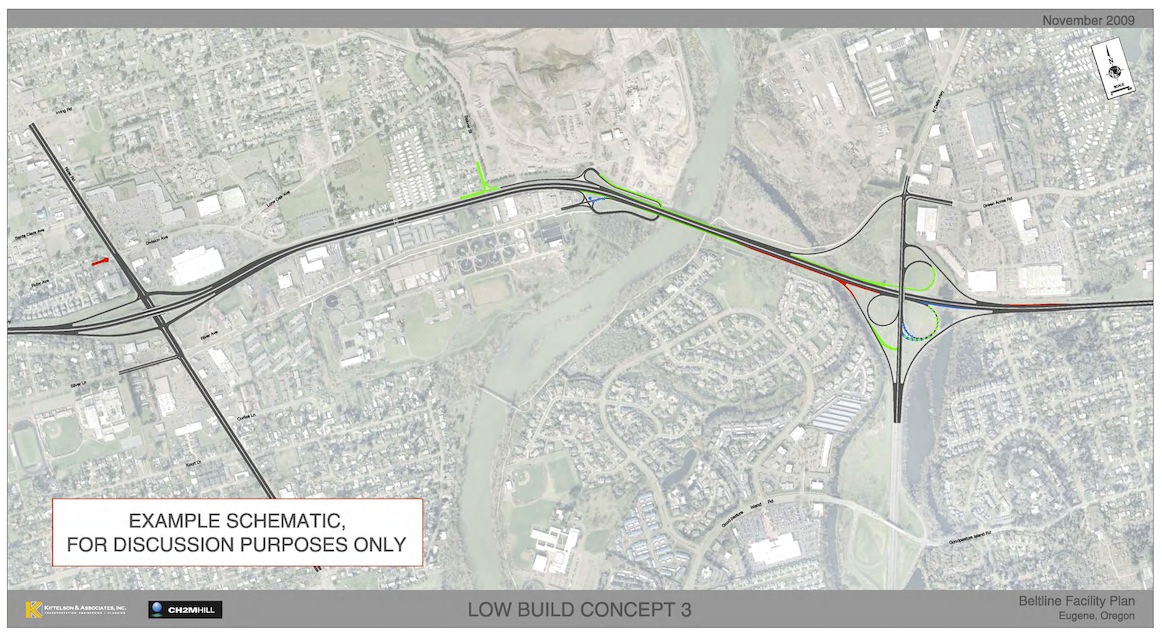
ODOT removed the "Low Build" options from the Beltline widening project, claiming that they are inadequate to address alleged increases in traffic volumes in the coming decades. But if Peak Traffic and constrained budgets were factored into their study, the Low Build option would be the Preferred Alternative.
The 2009 maps published by ODOT showed three Low Build options.
Low Build option one included longer off ramps for Beltline at the Delta interchange.
Low Build option two included option one plus longer on ramps from Delta and a tweak to the curvature of the Beltline eastbound to Delta northbound ramp. It also recommended disconnecting the onramp to Beltline east from River Avenue.
Low Build option three included one and two, plus changing the ramps at the Delta / Beltline interchange to remove the "weaving" problems for merging traffic. Eastbound Beltline traffic to northbound Delta would use the existing ramp to southbound Delta, but a traffic light would be added at Delta to facilitate a left turn onto northbound Delta. The attached map makes this easier to visualize. the merge lane for Delta to westbound Beltline would also be extended.
Low Build has been removed, but it's the only option that is affordable and appropriate for Peak Traffic and the declining Alaska Pipeline (which powers the motors of Oregon).
Low Build could be approved without wasting millions for a study of expanded options that won't be needed on the energy downslope. These millions of our dollars would be better spent fixing the Delta interchange ramps instead of giving them to consulting companies.
ODOT recently reduced the final total for the I-5 Beltline interchange by $6.2 million, removing the planned fourth lane for I-5 southbound from the interchange. This is probably in the range of what the Low Build option would cost.
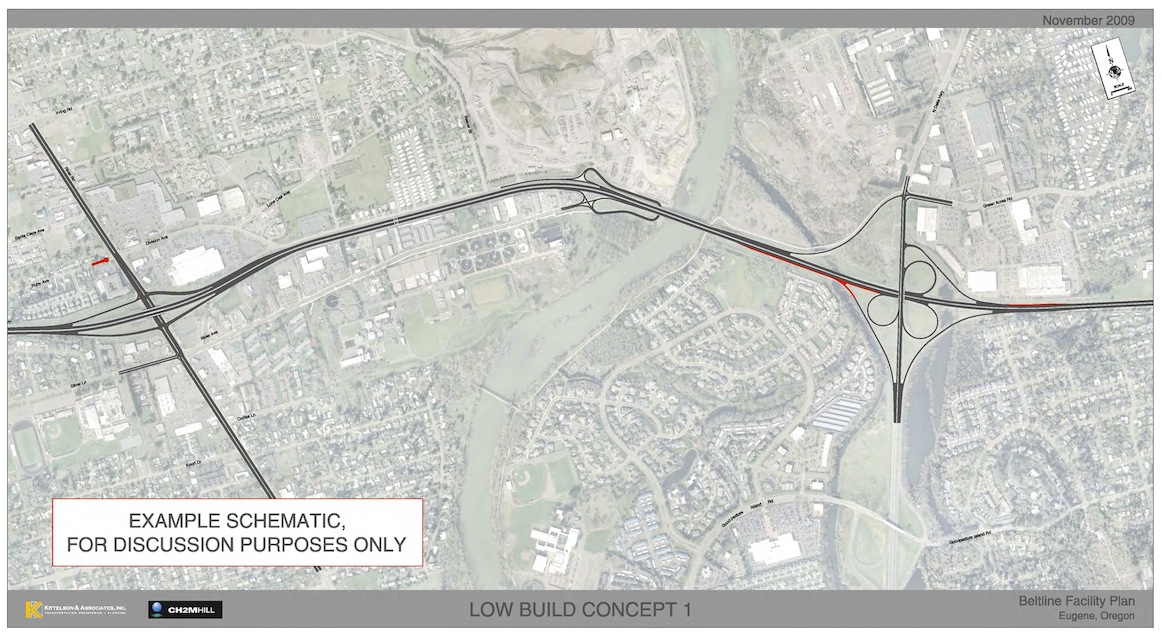
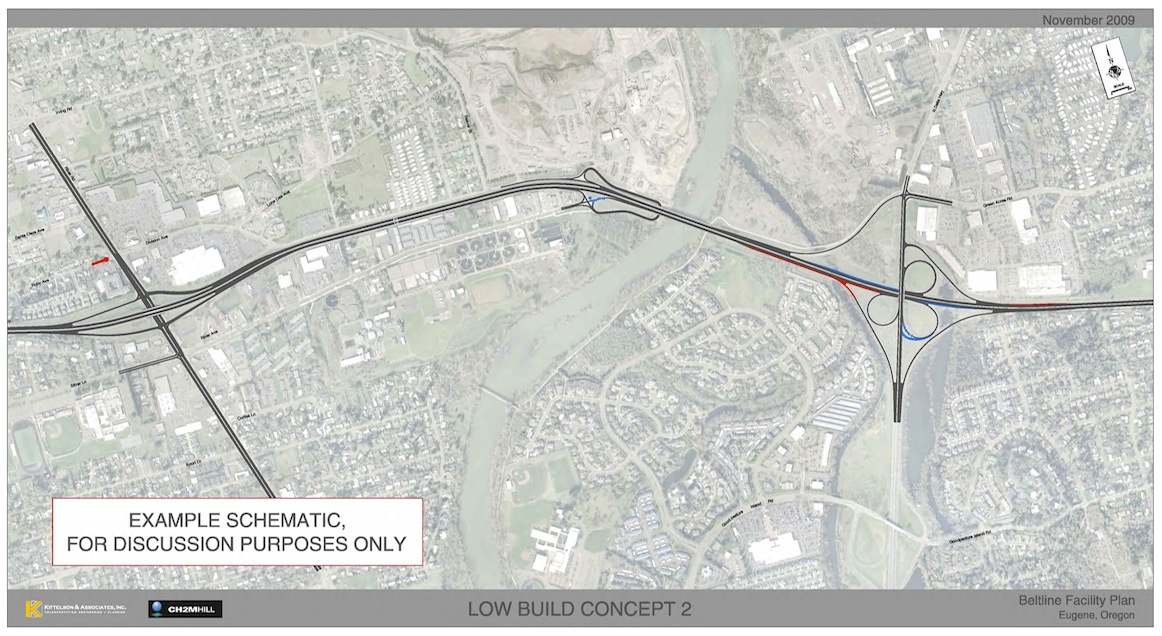
Delta / Beltline interchange reconstruction: underway 2019 - 2021
In late 2019, ODOT started reconstruction of the Beltline / Delta interchange. This is essentially the "Low Build" alternative for the Beltline study.
Reconstruction will change the "cloverleaf" ramps into a design where "weaving" no longer happens between those exiting and entering a highway. The recent expansion of Beltline / I-5 interchange eliminated the weaving points, but the rebuild was also significantly oversized. ODOT and local planners are hoping for huge population increases, more urbanization and expect electric cars to seamlessly bridge the transportation gap as the Alaska Pipeline reaches low flow shutdown and the fracking bubble ebbs, likely ushering in the era of permanent energy rationing.
There are two major parts. The first will convert the eastbound Beltline offramp to a traffic light intersection with Delta, with both left and right turn options. This removes the loop ramp (eastbound Beltline to northbound Delta), which is a difficult weaving section. The second part will add a new bridge over Beltline - the new northbound Delta to westbound Beltline off ramp. The bridge will be two lanes to add double capacity, which will force extra traffic demand on the capacity Beltline mainline. The "Low Build" alternative from ODOT seemed to only include a single lane exit on this section which is all that is needed for future demand, after Peak Everything.
We are at Peak Traffic, not less traffic. Modest redesigns like this may be appropriate to make existing uses safer.
www.oregon.gov/odot/projects/pages/project-details.aspx?project=19490
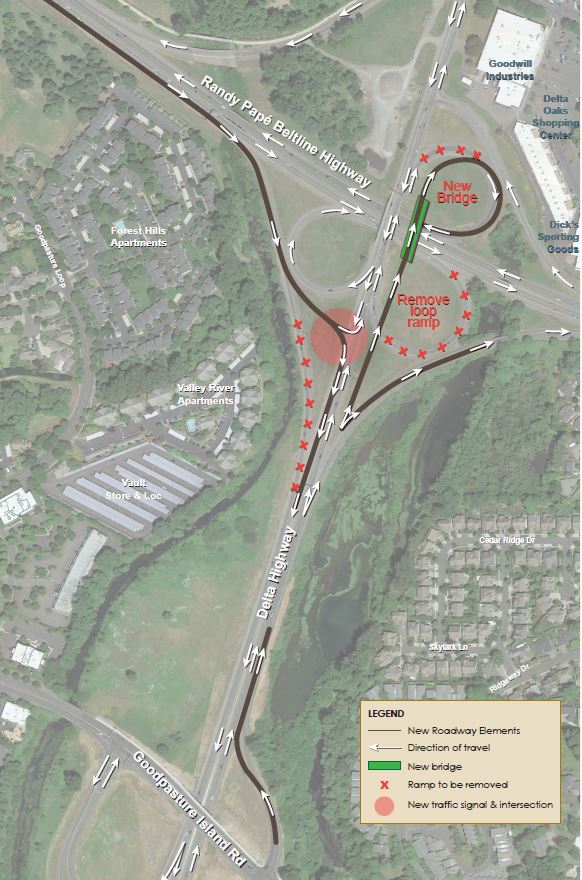
Peaked Traffic and Peaked Energy Alternative
Environmental Impact Statements are required to consider a range of alternatives, but ODOT (and Federal Highway Administration) have narrowed the study to focus solely on which expansion to approve. Two of their options would widen Beltline plus build a new four lane highway parallel to Beltline (even though the roads it would connect to are merely two lanes wide). A third option - the most expensive option - would add "collector distributor" lanes (local / express) to Beltline.
The National Environmental Policy Act (NEPA) requires revising a study with a Supplemental EIS when there are "new circumstances" relevant to a project. Reaching Peak Traffic (Vehicle Miles Traveled) and Peak Energy are such a circumstance, but none of the levels of government involved in this boondoggle want to admit this in public.
During the controversies over the West Eugene Porkway, the region's "Trans Plan" had an entry to allocate $13 million toward widening Beltline in north Eugene. One of the ODOT planners of the WEP told me that he thought $100 million would be a more realistic estimate for an expansion. But even this was an understatement. In 2008, the Governor's "Transportation Vision Committee" said the Beltline widening would cost $250 million. In 2014, the three options for widening ranged from just under this to a bit more.
Shortly after ODOT conceded the WEP was not going to be built, ODOT proposed widening Beltline to up to 11 lanes wide where it crosses the Willamette river. They didn't move forward with an Environmental Impact Statement since their regional priorities were the I-5 Beltline interchange and new bridges across the Willamette and McKenzie rivers. Now that those projects are completed, ODOT is refocusing attention on the Beltline widening.
ODOT assumes that Beltline will experience a 28% increase in traffic over the next two decades, necessitating massive widening of the highway. However, traffic peaked in Lane County in 2003 and the fuel source that powers this traffic - the Alaska Pipeline - continues to decline.
Fracking for oil in North Dakota has not reached the levels of Alaska's peak in 1988. In addition, fracked wells deplete much faster than conventional wells. Fracking is a short term bubble that will be much lower levels by the mid 2030s, when the Beltline project is ostensibly designed to address. (Federal law requires federal aid highways to plan for conditions two decades in the future.) In 2014, the US Department of Energy admitted that plans for fracking in California's Monterrey Shale were mostly an illusion and downsized estimated oil reserves by 96%.
Electric cars and hybrids might help mitigate the energy crisis, but they won't prevent depletion of oil (and coal and natural gas). These efficiency technologies require mineral ores which require fossil energy to mine and process. They will have minimal impact on slowing Peak Traffic on the energy downslope. Better options are at "Saving Oil in a Hurry (by being in less of a hurry)"
Albert Einstein cautioned that the splitting of the atom had changed everything except our way of thinking and thus we drift toward catastrophe. Today, we are in similar denial about reaching the limits to growth on a round, finite planet, the root cause of the environmental, energy and economic "triple crisis." Depletion denial is more widespread than climate change denial.
Seismic safety
Most of Oregon's highway infrastructure was built before the threat of the Cascadia Subduction Zone was discovered in the 1980s. Beltline's bridge across the river was built in the 1960s and probably would not survive the expected five minutes of severe shaking that the CSZ will cause.
ODOT has been scrambling for the past decade to try to repair worn out bridges, both due to the expected seismic risks as well as bridges in danger of closure due to overweight log trucks causing premature failure of these structures. The very real problems of worn out bridges is being used in a "bait and switch" campaign to persuade the public that highway widening is needed, even though the extra funds required to widen new bridges makes fixing the existing problems more difficult to fund. In other words, if worn out bridges were replaced with new ones of the same width, we would be more able to afford replacing "troubled bridges over water."
If the Beltline bridge is at the end of its life, then figuring out how to replace it - not triple its width - should be a priority, but this would not require spending hundreds of millions of dollars.
City government and climate group censorship about Beltline expansion plans
There is no mention of the Beltline expansion plans in the City's "Climate Action Plan 2.0," released in 2019. I have not found any mention of this project thing in the City's climate and sustainability promotional efforts.
Spending hundreds of millions to expand Beltline to facilitate overdevelopment in Santa Clara and north Eugene makes a mockery of the City's climate promises. The Beltline widening cost might be twice what was proposed for the West Eugene Porkway, but it would impact the river and nearby neighborhoods, not protected parklands that had legal power to block approval. The Climate Solutions Emperor might not be fully dressed.
I raised these and related concerns at City Council hearings about the Our Childrens' Trust co-authored Climate Recovery Ordinance. If there are groups that also mentioned Beltline expansion should be considered when evaluating the sincerity of the City's climate efforts, I have been unable to find them.
A former sustainability staffperson for the City privately told me that widening Beltline is a bad idea, but refused to say this in public.
The City's "Sustainability" Commission decided not to make a statement about the largest and most expensive infrastructure project during the rest of the oil era. (Only a minority of commisioners wanted to take a stand against supersizing Beltline.)
The climate groups in Eugene, especially Our Childrens' Trust and 350 Eugene, have declined many opportunities to highlight contradictions between the City's lofty statements about solving climate change and the massive widening of Beltline, among other toxic projects. Some individuals in those groups say in private they personally oppose it but as groups they have not dared challenge the city about highway expansions.
(One of the lawyers affiliated with Our Children's Trust told me a few years ago that it wasn't the role of environmentalists to stop highways. Perhaps this lawyer does not know about the Supreme Court's 1971 "Overton Park" decision, one of the most significant environmental legal victories. The Court affirmed "Section 4(f)," a 1966 federal law that bans federally funded transportation projects through parks. 4(f) is the main law that prevented the West Eugene Porkway and has stopped more highways than any other legal obstacle.)
350 Eugene held a transportation event several months ago to discuss electric cars and public transit. The topic of Beltline widening was ruled irrelevant, even by some who privately have said they are against it.
(One of the core 350 Eugene activists owns an electric car with a hand made sign claiming that it is carbon-neutral because some of its electricity comes from a residential solar panel array. Electric cars are efficient, not sustainable, because of fossil energy and mineral ore inputs to make the car. It also takes finite fossil concentrated carbon to build and maintain roads. plus resources used for road construction and maintenance. Sorry.)
The City 's climate laws mandates giving public funds to private marketers of carbon offsets to pretend that EUG airport expansion and Beltline widening could be made "carbon neutral." Giving money to friends of Good Company consultancy to buy carbon credits does not put fossil fuel combustion products back into the Earth's crust. Expanding airports and highways is the exact opposite approach toward mitigating climate chaos and peak everything.
In Portland, in contrast, Sunrise Movement and other climate groups joined with the No More Freeways PDX coalition to oppose a proposed half billion dollar, 8 lane widening of I-5 from I-405 to I-84 east of the Willamette river. On December 10, 2019, these groups picketed ODOT's planning office in downtown Portland. The following Tuesday, the Oregon Transportation Commission postponed its rubber stamp approval of this expansion. They did not cancel the plan, nor shift their study to consider climate chaos, air pollution impacts on the neighbors (especially Harriet Tubman elementary school), peak oil, peak Vehicle Miles Traveled or the looming low flow shut down of the Alaska Pipeline.. ODOT merely put the ultimate record of decision on hold until they can "study" it some more. This studying is a means to deflect public concern and to strengthen the legal case for the expansion, but it buys time for the freeway fighters to expand their opposition. Portland and Eugene have long histories of stopping highway expansions.
